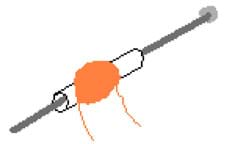Quick Look
Grade Level: 5 (5-7)
Time Required: 1 hour
Expendable Cost/Group: US $3.00 This activity also requires some non-expendable items; see the Materials List for details.
Group Size: 3
Activity Dependency: None
Subject Areas: Physics, Science and Technology
NGSS Performance Expectations:

| MS-PS2-3 |
| MS-PS2-5 |

Summary
Using plastic straws, wire, batteries and iron nails, student teams build and test two versions of electromagnets—one with and one without an iron nail at its core. They test each magnet's ability pick up loose staples, which reveals the importance of an iron core to the magnet's strength. Students also learn about the prevalence and importance of electromagnets in their everyday lives.Engineering Connection
Great minds such as Maxwell, Faraday and Gauss made discoveries that continue to shape our modern world. It's a fact that electricity and magnetism affect every modern industry, including communication, entertainment, medicine, warfare and manufacturing. Engineers design electromagnets into uncountable electronic products, home appliances, vehicles, medical equipment and power plants. This activity is based on one of Maxwell's equations, Faraday's law of induction, the principle behind electric generators. The importance of the concept of induction is critical since this serves as the basis for electricity generation to power our homes and businesses.
Learning Objectives
After this activity, students should be able to
- Describe what an electromagnet is.
- Explain how current produces a magnetic field.
- Describe the interconnection of electricity and magnetism.
- Identify how an iron core affects the characteristics of an electromagnet.
Educational Standards
Each TeachEngineering lesson or activity is correlated to one or more K-12 science,
technology, engineering or math (STEM) educational standards.
All 100,000+ K-12 STEM standards covered in TeachEngineering are collected, maintained and packaged by the Achievement Standards Network (ASN),
a project of D2L (www.achievementstandards.org).
In the ASN, standards are hierarchically structured: first by source; e.g., by state; within source by type; e.g., science or mathematics;
within type by subtype, then by grade, etc.
Each TeachEngineering lesson or activity is correlated to one or more K-12 science, technology, engineering or math (STEM) educational standards.
All 100,000+ K-12 STEM standards covered in TeachEngineering are collected, maintained and packaged by the Achievement Standards Network (ASN), a project of D2L (www.achievementstandards.org).
In the ASN, standards are hierarchically structured: first by source; e.g., by state; within source by type; e.g., science or mathematics; within type by subtype, then by grade, etc.
NGSS: Next Generation Science Standards - Science
| NGSS Performance Expectation | ||
|---|---|---|
|
MS-PS2-3. Ask questions about data to determine the factors that affect the strength of electric and magnetic forces. (Grades 6 - 8) Do you agree with this alignment? |
||
| Click to view other curriculum aligned to this Performance Expectation | ||
| This activity focuses on the following Three Dimensional Learning aspects of NGSS: | ||
| Science & Engineering Practices | Disciplinary Core Ideas | Crosscutting Concepts |
| Ask questions that can be investigated within the scope of the classroom, outdoor environment, and museums and other public facilities with available resources and, when appropriate, frame a hypothesis based on observations and scientific principles. Alignment agreement: | Electric and magnetic (electromagnetic) forces can be attractive or repulsive, and their sizes depend on the magnitudes of the charges, currents, or magnetic strengths involved and on the distances between the interacting objects. Alignment agreement: | Cause and effect relationships may be used to predict phenomena in natural or designed systems. Alignment agreement: |
| NGSS Performance Expectation | ||
|---|---|---|
|
MS-PS2-5. Conduct an investigation and evaluate the experimental design to provide evidence that fields exist between objects exerting forces on each other even though the objects are not in contact. (Grades 6 - 8) Do you agree with this alignment? |
||
| Click to view other curriculum aligned to this Performance Expectation | ||
| This activity focuses on the following Three Dimensional Learning aspects of NGSS: | ||
| Science & Engineering Practices | Disciplinary Core Ideas | Crosscutting Concepts |
| Conduct an investigation and evaluate the experimental design to produce data to serve as the basis for evidence that can meet the goals of the investigation. Alignment agreement: | Forces that act at a distance (electric, magnetic, and gravitational) can be explained by fields that extend through space and can be mapped by their effect on a test object (a charged object, or a ball, respectively). Alignment agreement: | Cause and effect relationships may be used to predict phenomena in natural or designed systems. Alignment agreement: |
International Technology and Engineering Educators Association - Technology
-
Students will develop an understanding of the role of society in the development and use of technology.
(Grades
K -
12)
More Details
Do you agree with this alignment?
-
Students will develop an understanding of the relationships among technologies and the connections between technology and other fields of study.
(Grades
K -
12)
More Details
Do you agree with this alignment?
State Standards
Florida - Science
-
Investigate and describe some basic forms of energy, including light, heat, sound, electrical, chemical, and mechanical.
(Grade
5)
More Details
Do you agree with this alignment?
-
Investigate and explain that electrical energy can be transformed into heat, light, and sound energy, as well as the energy of motion.
(Grade
5)
More Details
Do you agree with this alignment?
Materials List
Each group needs:
- plastic drinking straw
- high-gauge wire (28, 30 or 32 gauge), 2 ft (.6 m)
- iron nail
- loose staples
- 9V battery
- alligator clips
- scissors
- wire strippers
- The Good, the Bad and the Electromagnet Worksheet, one per student
- For the post-activity assessment: paper clips, and more wire and batteries
Worksheets and Attachments
Visit [www.teachengineering.org/activities/view/usf_maxwell_lesson01_activity2] to print or download.Introduction/Motivation
Electromagnets can be found in many electronic products and home appliances. They are found in our cars. They start the motor, and in some cars, roll windows up and down, and lock and unlock our doors. They exist in our homes. They spin our fans in the ceiling and in our ACs. They exist in our power plants. They are used to generate the electricity that is distributed far and wide. They're in our hospitals. They produce the strong fields found in MRI machines, and are sometimes used in tracking heart rate and blood pressure. As can be seen, electromagnets are present in a significant part of our lives.
Today's activity deals with how a piece of iron bar can be used to enhance the power of an electromagnet. We have all seen how magnets attract objects made of iron. If we make a simple electromagnet using nothing more than a wire and a battery, the magnetic field produced is enough to deflect the needle of a compass. However, unless we have a sufficient length of wire and sufficient battery power, the magnetic field will not be strong enough to move anything heavier than the compass needle. However, another way exists to increase the power of an electromagnet.
Iron has a unique property in which each atom is a small magnet. Unfortunately, the atoms are all disoriented and each magnet points in a different direction. Due to their disorientation, all the magnetic fields from each of the molecules cancel each other out. This causes any piece of iron as a whole to have no noticeable magnetic properties by itself.
When a magnetic field, such as that produced by a magnet or a powered solenoid, is introduced, the iron atoms line up magnetically. This turns the iron into a magnet itself and increases the strength of the introduced magnetic field. Therefore, a solenoid, whose magnetic field is not strong enough to lift a single staple, when combined with an iron core, such as a nail, can lift several staples at once. It is this property that makes electromagnets usable in devices such motors and magnetic lifts.
Steel and other metals, which also show signs of being affected by magnets, do not have this same characteristic. Instead, in other metals, when an electric field is introduced, the atoms and molecules merely create an equal magnetic field. This causes them to be susceptible to magnetic fields, but does not give them the ability to intensify a field.
Procedure
Background
Electromagnets are temporary magnets that are created by running a current through a coil of wire wrapped in a loop. Typically, this loop is wound around a piece of metal such as iron or iron compound. Electromagnets act just like regular magnets except that they lose their magnetic properties once current ceases to flow in the wire.
Before the Activity
- Gather materials and make copies of The Good, the Bad and the Electromagnet Worksheet.
- Divide the class into teams of two to four students each.

With the Students
- Hand out the worksheets and have student teams follow along with them to conduct the activity, answering the worksheet questions as they go.
- Leaving 3 to 4 inches at either end of the wire, wrap the wire around the straw. Attempt to keep the wire all together in a small area (see Figure 1).
- Using the scissors, cut off the straw before and after the wire coil.
- Using the blade of the wire strippers, strip the coating off the wire ends.
- Spread loose staples out on a table.
- Using the alligator clips, connect the wire to the terminals of a battery.
- Try using the coil, which is now an electromagnet, to pick up the staples.
- Record how many staples you were able to lift at once.
- Disconnect the battery.
- Now, slip the nail into the straw sleeve so that the wire coil is positioned around the nail (see Figure 2).

- Reconnect the battery.
- Attempt to pick up the staples again.
- Record how many staples were picked up this time.
- Conclude with a class discussion to compare observations and results. Make the point that, with an iron core, the solenoid is able to pick up more staples than before. Students also may have noticed a shift in the core (if it is not fitted tightly inside the straw) when battery power is applied. This property of sliding core of a solenoid is used in electric circuits as switches. For example, a solenoid is used to operate a switch in the car starter motor. As we turn the ignition key, it powers a solenoid, the sliding core of which then closes a switch, which in turn allows battery power to turn the engine.
- Conduct the post-activity assessment (using paper clips), as described in the Assessment section.
- Have students complete and hand in their activity worksheets.
Vocabulary/Definitions
current: A flow of electric charge. Current can also be described as the rate of flow of electric charges. In most cases, current is associated with the flow of electrons.
electricity: Any phenomena that can be associated with the presence or flow of electric charges.
electromagnet: A type of magnet in which the magnetic field is produced by the flow of current. A temporary magnet created by running a current through a coil of wire that is wrapped in a loop; usually this loop is wound around a piece of metal such as iron or iron compound.
magnetism: The energy and forces associated with magnetically charged particles, such as those found in bar magnets; due to the Earth having a magnetic field that consistently points in the same direction, magnets have for a long time been used in navigation; magnetism is due to the movement of electrically charged particles, such as electrons.
solenoid: A coil of wire used in generating a magnetic field.
voltage: Common name for electric potential difference. It is the driving force for electric current traveling from a point A to B; expressed in volts.
Assessment
Activity Embedded Assessment
Worksheet: Have students complete The Good, the Bad and the Electromagnet Worksheet questions. Review their answers to gauge their mastery of the subject.
Post-Activity Assessment
Understanding of Electromagnets: Having dealt with electromagnetics in some intensity, ask each student what they would do in order to increase the intensity of the electromagnet. Then have them construct experiments to test their hypotheses. Use the number of paper clips picked up as the dependent variable. (Possible methods: Wrap more coils of wire around the straw; add an extra battery in series [be careful in this part, as the batteries heat up quicker]; bundle a few iron nails together and wrap the wire around them.)
Subscribe
Get the inside scoop on all things TeachEngineering such as new site features, curriculum updates, video releases, and more by signing up for our newsletter!More Curriculum Like This

Students are briefly introduced to Maxwell's equations and their significance to phenomena associated with electricity and magnetism. Basic concepts such as current, electricity and field lines are covered and reinforced. Through multiple topics and activities, students see how electricity and magne...

Students induce EMF in a coil of wire using magnetic fields. Students review the cross product with respect to magnetic force and introduce magnetic flux, Faraday's law of Induction, Lenz's law, eddy currents, motional EMF and Induced EMF.

Students learn more about magnetism, and how magnetism and electricity are related in electromagnets. They learn the fundamentals about how simple electric motors and electromagnets work. Students also learn about hybrid gasoline-electric cars and their advantages over conventional gasoline-only-pow...

Students investigate the properties of magnets and how engineers use magnets in technology. Specifically, students learn about magnetic memory storage, which is the reading and writing of data information using magnets, such as in computer hard drives, zip disks and flash drives.
Copyright
© 2013 by Regents of the University of Colorado; original © 2011 College of Engineering, University of South FloridaContributors
Mandek Richardson and James Cooper (under the advisement of Patricio Rocha, Dayna Martinez and Tapas K. Das)Supporting Program
STARS GK-12 Program, College of Engineering, University of South FloridaAcknowledgements
This curriculum was developed by the USF Students, Teachers and Resources in Sciences (STARS) Program under National Science Foundation grant numbers DGE 0139348 and DGE 0638709. However, these contents do not necessarily represent the policies of the NSF, and you should not assume endorsement by the federal government.
Last modified: April 26, 2019









User Comments & Tips